The main purpose of the hood for exhaust ventilation is to protect vertical ventilation ducts from rain, snow, foliage. Even such a small part of the exhaust ventilation as an umbrella must comply with technical standards. An unsuitable ventilation hood can result in poor draft, precipitation into the system or clogging.
The size and type of umbrella is selected depending on the parameters of the throat of the ventilation duct. Protective devices are produced in accordance with TU and GOST, their dimensions and characteristics are determined by SNiPs.
Types of ventilation hoods
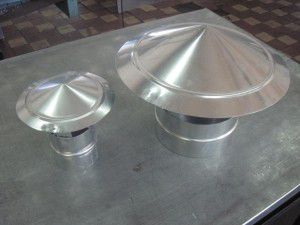
Depending on the shape and purpose, exhaust ventilation hoods are:
- round;
- rectangular;
- exhaust;
- sewer.
Round ventilation hoods
Round umbrellas are installed on the tops of ventilation pipes of the corresponding section. They are suitable for systems with any type of draft, protecting pipes from precipitation. The umbrellas are fastened with a bandage, flange or nipple connection.
Round umbrellas for ventilation systems are produced from:
- galvanized sheet steel;
- copper;
- PVC;
- of stainless steel.
Plastic is used mainly for the production of ventilation hoods.
Some models are supplemented with a net covering the outlet from small rodents, birds, dry foliage.
Rectangular ventilation hoods
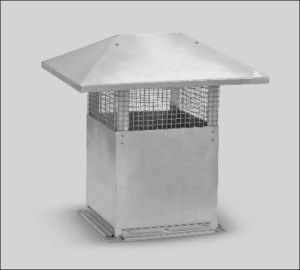
Rectangular and square ventilation hoods are usually installed on insulated exhaust shafts. Fastened with a nipple connection.
Rectangular umbrellas for ventilation are produced from sheet steel with a thickness of 0.55 - 1 mm according to TU. The aspect ratio can be selected depending on the mine project, but taking into account the GOST for ventilation system umbrellas. The outlet of the rectangular hood can also be covered with a mesh.
Sewer ventilation hoods
PVC umbrellas for ventilation of internal sewerage have the same protective function, but they also regulate the pressure in the pipes. The ventilation umbrella is installed on the head of a non-pressure sewer pipe, it can withstand up to +60 degrees. For fastening PVC ventilation hoods, a socket joint is used, which is sealed with a rubber ring that does not allow leakage.
GOST requirements for PVC umbrellas for ventilation systems:
| Diameter in mm | Weight, gr |
| 50 | 890 |
| 110 | 1230 |
The diameters of PVC ventilation hoods coincide with the standard size range of sewer pipes and can be 50 or 110 mm. Umbrellas for ventilation made of PVC are produced only for a circular cross-section.
Exhaust ventilation hoods
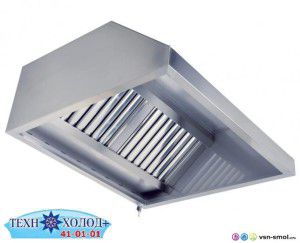
Exhaust hoods are installed in the kitchens of cafes and restaurants above the hobs and ovens. Hot air and steam rise up and immediately enter the canopy. To increase efficiency, a fan is often built into the umbrella. There are also supply and exhaust models of kitchen umbrellas.
Exhaust ventilation hoods can be:
- Wall mounted. They are hung on the wall above the heat and moisture source. Small-diameter umbrellas are attached only to the wall, larger ones in addition to the ceiling with chains;
- Central. Such umbrellas are installed with the "island" arrangement of the plates.The optimal effect is achieved by arranging two umbrellas, which are attached to each other with their back surfaces, and to the ceiling with chains.
At catering establishments, wall-mounted ventilation umbrellas are often installed.
Any umbrella model consists of a body and labyrinth filters, which are periodically dismantled for washing. All parts are made of food grade stainless steel, resistant to heat, moisture, grease and detergents.
Central and wall-mounted ventilation hoods are equipped with a drain channel and storage tanks, into which grease flows from the filters.
The principle of operation of central and wall umbrellas for ventilation is quite simple: hot air with oil particles hits the walls of the labyrinth filter, condensation of oils occurs, which, as they accumulate, drain into storage tanks through sealed drain pipes. A small amount of detergent is poured into the storage containers to facilitate cleaning. Glasses are cleaned 1 time in 7 days.
Main characteristics
As a rule, do-it-yourself exhaust ventilation umbrellas are not made. Therefore, when choosing, the main parameters that determine the work will come in handy:
- Dimensions. The width of the dome should be 10 cm wider than the surface of the slab. For example, if the hob is 450 mm wide, the umbrella is 550 mm or more. Otherwise, it will not be able to efficiently capture steam and fats;
- Air speed and drag. Air resistance and air velocity depend on the design of the labyrinth filter. In order for all the oil to settle on its walls, the air speed must be within 0.8 - 1.5 meters per second. Otherwise, the quality of the umbrella will noticeably decrease;
- Inside temperature. If the temperature in the umbrella is above +100 degrees, the fat will evaporate and settle in the air duct;
- Air consumption. This is one of the most important indicators, which is calculated depending on the volume of the room, the power and number of stoves and ovens, and the intensity of the workshop.
As you can see, it is not easy to make a ventilation umbrella with your own hands. There are GOSTs for umbrellas of ventilation systems, regulating the dimensions, characteristics and materials for their manufacture.
Scheme and dimensions of roof ventilation hoods
Unlike kitchen umbrellas, ventilation system umbrellas made of galvanized sheet steel are easy to make yourself.
The simplest umbrella for a ventilation system is made of galvanized steel sheet. It consists of a cone-shaped roof, a cylindrical base and 3 holding legs.
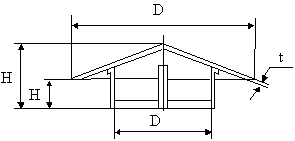
To work, you need the following tools:
- galvanized sheet;
- a sheet of cardboard;
- pencil;
- ruler;
- compass;
- scissors for metal;
- rivets or bolts with nuts.
When starting to create a ventilation umbrella with your own hands, you need to familiarize yourself with the size ratio.
Dimensions in centimeters:
| D1 | D | H | h | T (in mm) |
| 20 | 35 | 24 | 0,7 | |
| 25 | 45 | 25,7 | 15 | 0,7 |
| 31,5 | 55 | 27,5 | 1 | |
| 40 | 70 | 40 | 25 | 1 |
| 45 | 80 | 41,5 | 1 | |
| 50 | 90 | 48 | 1 | |
| 63 | 113 | 52,3 | 30 | 1 |
| 71 | 130 | 55 | 1 | |
| 80 | 145 | 82 | 53,8 | 1,5 |
| 100 | 180 | 97 | 1,5 | |
| 125 | 225 | 105,5 | 63,8 | 1,5 |
Dimensions in centimeters:
Execution 1
| BUT* | B * | H | H1 |
| 25 | 45 | 24 | 15 |
| 40 | 72 | 37,6 | 25 |
| 50 | 90 | 40 | 25 |
| 80 | 144 | 76,3 | 53,8 |
| 100 | 180 | 81,1 | 53,8 |
Execution 2
| BUT* | B * | B1 * | B2 * | H | H1 |
| 25 | 45 | 40 | 72 | 40 | 25 |
| 50 | 90 | 80 | 144 | 93 | 63,8 |
| 80 | 144 | 100 | 180 | 99,5 | 63,8 |
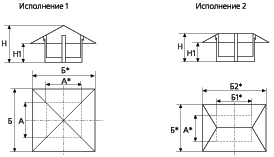
Work progress:
- On a sheet of cardboard, draw a drawing of the individual parts of the umbrella (legs, roof and holder legs), using the above diagrams and dimensions;
- Cut out every detail and get patterns;
- Transfer images to metal, cut using metal scissors;
- Rivet the metal. When the leg and roof are ready, connect them together with the legs.
We recommend that you first assemble a paper model of the future umbrella and check the correctness of the calculations.
Although a homemade tin product can regularly serve for more than a dozen years, plastic products are more often used as sewer ventilation umbrellas. They are very neat, practical and durable.
Video review of a plastic sewer umbrella (fungus):








